The Saturn Nebula (NGC 7009) is a small but bright planetary nebula located between 2,000 and 4,000 light years away in the constellation Aquarius. With an apparent magnitude of 8.0, it is one of the brightest planetary nebulae in the sky. It is listed as Caldwell 55 (C55) in the Caldwell catalogue of objects visible in amateur telescopes.
The Saturn Nebula has an apparent size of 41″ by 35″, which corresponds to a linear radius between 0.2 and 0.4 light years, depending on the nebula’s exact distance. Some recent estimates place NGC 7009 as far as 5,200 light-years away. The nebula’s bright central region measures 25″ by 17″ across.
Like all planetary nebulae, the Saturn Nebula formed when a low-mass star reached the end of its life and expelled its outer layers into space. The star’s former outer layers form complex shapes and intricate structures that are made visible by the light of the hot stellar core. The ejected gaseous envelope is lit by the strong ultraviolet radiation of the remnant of the doomed star. The radiation of the doubly ionized oxygen gives the nebula a greenish glow.
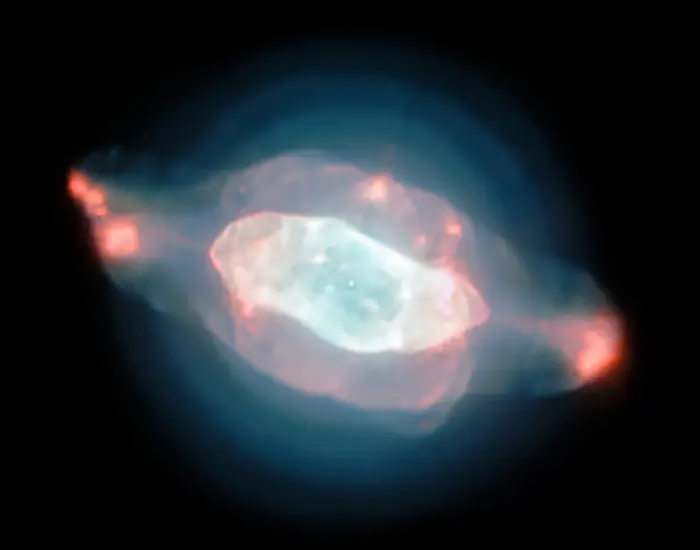
The spectacular planetary nebula NGC 7009, or the Saturn Nebula, emerges from the darkness like a series of oddly-shaped bubbles, lit up in glorious pinks and blues. This colourful image was captured by the powerful MUSE instrument on ESO’s Very Large Telescope (VLT), as part of a study which mapped the dust inside a planetary nebula for the first time. The map — which reveals a wealth of intricate structures in the dust, including shells, a halo and a curious wave-like feature — will help astronomers understand how planetary nebulae develop their strange shapes and symmetries. In order to better understand how planetary nebulae are moulded into such odd shapes, an international team of astronomers led by Jeremy Walsh from ESO used the Multi Unit Spectroscopic Explorer (MUSE) to peer inside the dusty veils of the Saturn Nebula. MUSE is an instrument installed on one of the four Unit Telescopes of the Very Large Telescope at ESO’s Paranal Observatory in Chile. It is so powerful because it doesn’t just create an image, but also gathers information about the spectrum — or range of colours — of the light from the object at each point in the image. The team used MUSE to produce the first detailed optical maps of the gas and dust distributed throughout a planetary nebula. The resulting image of the Saturn Nebula reveals many intricate structures, including an elliptical inner shell, an outer shell, and a halo. It also shows two previously imaged streams extending from either end of the nebula’s long axis, ending in bright ansae (Latin for “handles”). Image credit: ESO/J. Walsh (CC BY 4.0 DEED)
Planetary nebulae are the final stage in the lives of Sun-like stars, which are not massive enough to end their lives as supernovae. When these stars run out of their supply of fuel, they evolve into red giants and lose a lot of their initial mass through strong stellar winds. The outer shell of the Saturn Nebula is composed of material ejected from the central star in the red giant phase of its life cycle. Our own Sun will have a similar fate in about 5-6 billion years. Like the central star in NGC 7009, it will end its life as a dim white dwarf.
Planetary nebulae are short-lived phenomena, astronomically speaking. They typically last only several thousand years. As the central stars vent their atmospheres into space, the outer surfaces of their exposed cores reach temperatures of more than 30,000 K and start emitting enough ultraviolet photons to ionize the expelled material and cause it to glow.
The progenitor stars eventually cool so much that they can no longer ionize the expanding clouds of gas and they evolve into white dwarfs. The expanding nebular material may eventually be recycled to form new generations of stars and planets.
The bright central star at the heart of the Saturn Nebula has a visual magnitude of 11.5 and a surface temperature of 55,000 K. It has an absolute magnitude of +1.5, corresponding to a luminosity about 20 times that of the Sun. The nebula is moving toward us with a radial velocity of 28 miles per second.
The nebula has a complex structure consisting of a number of sub-systems, including jet-like streams, several shells, filaments, knots, ansae and a halo. The ansae (“handles” of low-density gas protruding from either side of the disk) expand non-radially from the progenitor star along the long axis of the nebula. They appear particularly striking in NGC 7009, but have also been observed in other planetary nebulae, including the Cat’s Eye Nebula (NGC 6543) in Draco, the Ghost of Jupiter (NGC 3242) in Hydra, and NGC 2371-2 in Gemini.
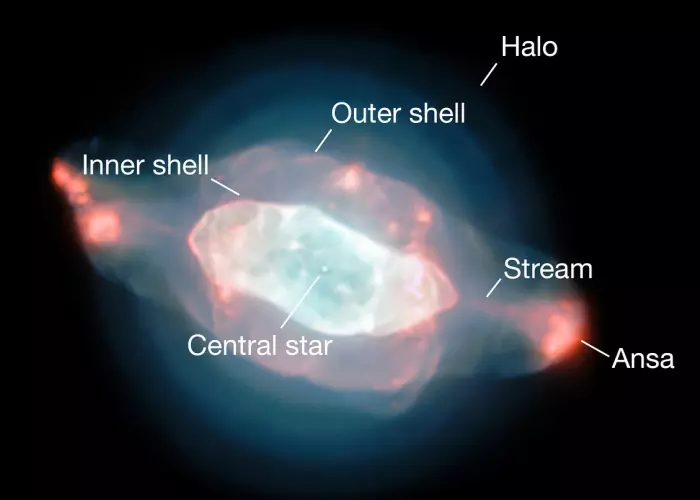
A map of the Saturn Nebula, image credit: ESO/J. Walsh (CC BY 4.0 DEED)
In 2016, the Saturn Nebula was studied by the Multi Unit Spectroscopic Explorer (MUSE) instrument, installed at the Very Large Telescope (VLT) of the European Southern Observatory’s (ESO) Paranal Observatory in Chile. An international team of astronomers led by Jeremy Walsh of the ESO accurately mapped the nebula to better understand its structure. This was the first time that astronomers mapped dust extinction inside a typical planetary nebula. The unusual cases of the Jewel Bug Nebula (NGC 7027) in Cygnus and the Butterfly Nebula (NGC 6302) in Scorpius were mapped in 1988 and 2005 respectively.
The team discovered a wave-like feature in the dust, which is typically evenly distributed throughout a nebula. However, the rim of the inner shell in the Saturn Nebula has a distinct lack of dust. This has led astronomers to speculate that the dust is being destroyed in this part of the nebula, either by an expanding shock wave (in the form of the nebula’s expanding inner shell) smashing into it and destroying it or a shock wave causing a strong heating effect that evaporates the dust. By using MUSE to map planetary nebulae’s complex structures, astronomers are hoping to shed some light on the role that dust and gas play in the life cycles of low-mass stars, as well as on the ways that the complex structures of these nebulae form.
In a subsequent study, Walsh and his colleagues found that the dust extinction map of the Saturn Nebula has considerable structure, and that the dust structures roughly correspond to the nebula’s morphological features. The researchers investigated the wave feature but did not identify plausible mechanisms that could have produced it, other than mass loss variations in an AGB star.
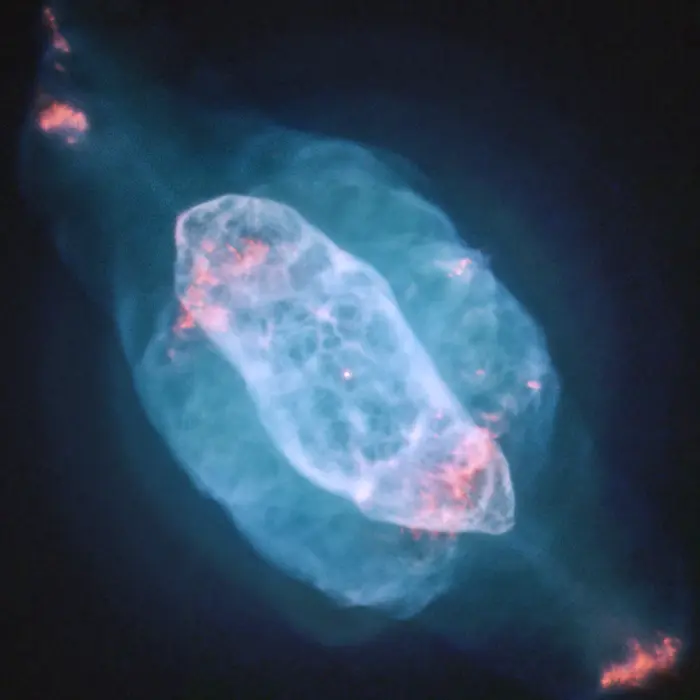
Saturn Nebula (Caldwell 55), image credit: Judy Schmidt (CC BY 2.0 DEED)
Facts
The Saturn Nebula was discovered by the German-born British astronomer William Herschel on September 7, 1782. Herschel used his own home-built telescope to observe this area of the sky from his home in Datchet, England. NGC 7009 was one of the first objects he discovered.
Herschel himself coined the term planetary nebula because these objects appeared similar to planets in early telescopes. Their small blue-green disks made them look like the planet Uranus, which he had discovered in March 1781.
The nebula’s name comes from the 19th century Anglo-Irish astronomer William Parsons, 3rd Earl of Rosse. In the 1840s, Lord Rosse named the object the Saturn Nebula because it resembled the planet Saturn, appearing with its rings almost edge-on. At the time, telescopes had been refined enough to reveal the nebula’s Saturn-like shape.
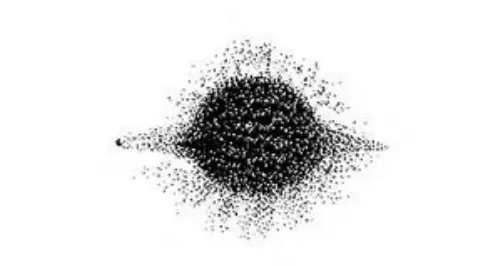
A sketch of the Saturn Nebula by by William Parsons, 3rd Earl of Rosse, 1848
English astronomer Admiral William Henry Smyth said the nebula was one of Baltic German astronomer Friedrich Georg Wilhelm von Struve’s nine “Rare Celestial Objects” appended to the Dorpat Catalogue (Catalogus Novus Stellarum Duplicium) of 1827. Other objects on Struve’s list included the planetary nebulae NGC 6210 (the Turtle Nebula) in Hercules and the Emerald Nebula (NGC 6572) in Ophiuchus, the globular clusters Messier 53 in Coma Berenices and the Great Pegasus Cluster (Messier 15) in Pegasus, the disrupted elliptical galaxy NGC 3077 in Ursa Major, and the dwarf galaxy Messier 32 in Andromeda.
The Saturn Nebula appears similar to the Blinking Planetary Nebula (NGC 6826) in the constellation Cygnus. Both nebulae have a bright central star, an elliptical inner shell, and ansae accompanied by jets along the long axes. However, the Saturn Nebula has a more elongated inner shell than the fainter Blinking Planetary. Both nebulae are listed in Sir Patrick Moore’s Caldwell catalogue.
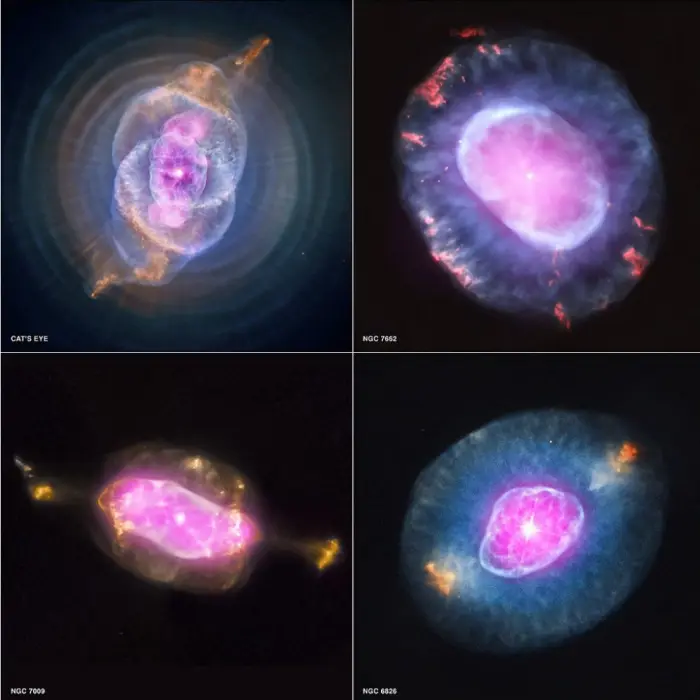
This gallery shows four planetary nebulas from the first systematic survey of such objects in the solar neighborhood made with NASA’s Chandra X-ray Observatory. The planetary nebulas shown here are NGC 6543 (aka the Cat’s Eye), NGC 7662, NGC 7009 and NGC 6826. X-ray emission from Chandra is colored purple and optical emission from the Hubble Space Telescope is colored red, green and blue. A planetary nebula is a phase of stellar evolution that the sun should experience several billion years from now, when it expands to become a red giant and then sheds most of its outer layers, leaving behind a hot core that contracts to form a dense white dwarf star. A wind from the hot core rams into the ejected atmosphere, creating the shell-like filamentary structures seen with optical telescopes. The diffuse X-ray emission is caused by shock waves as the wind collides with the ejected atmosphere. The properties of the X-ray point sources in the center of about half of the planetary nebulas suggest that many central stars responsible for ejecting planetary nebulas have companion stars. Image: Chandra X-ray Observatory Center, Smithsonian Institution @ Flickr Commons
Location
The Saturn Nebula lies in the constellation of Aquarius. It appears in a faint region of the sky of the celestial Water Bearer, near the border with Capricornus. It can be found southwest of the imaginary line connecting Fomalhaut in Piscis Austrinus and Altair in Aquila, and southeast of the line drawn from Sadalsuud in Aquarius to Dabih in Capricornus.
The nebula lies in the western part of Aquarius, about a degree west of Nu Aquarii (mag. 4.52) and 2 degrees northeast of the asterism Messier 73. It appears on the imaginary line extended from Deneb Algedi, the brightest star in Capricornus, to Albali (Epsilon Aquarii, mag. 3.77) in Aquarius.
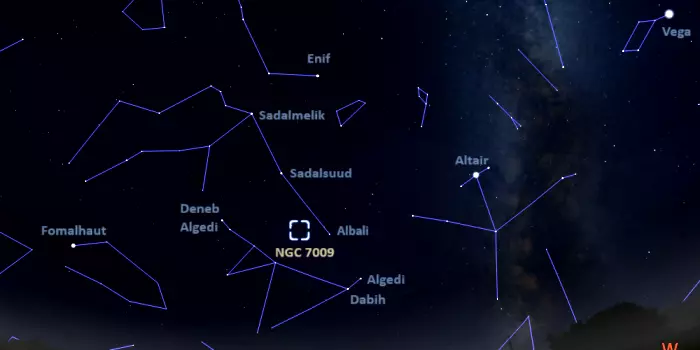
The location of the Saturn Nebula (NGC 7009), image: Stellarium
The Saturn Nebula can be seen in amateur telescopes and appears as a hazy greenish or yellowish patch. Small telescopes will show a star-like object, but larger instruments will reveal more of the nebula’s structure, including the two extended lobes that resemble Saturn’s rings. The nebula is easily observed in 8-inch telescopes and is best seen at high magnification. In 10-inch telescopes, the ansae in the nebula may be spotted in exceptionally good viewing conditions. The fainter outer regions of NGC 7009 are best seen at high magnification using averted vision.
The best time of the year to observe the Saturn Nebula and other deep sky objects in Aquarius is in the month of October, when the constellation appears higher in the evening sky. At declination -11°, the nebula is close enough to the celestial equator to be visible from virtually anywhere on Earth for at least part of the year.
Saturn Nebula – NGC 7009
| Constellation | Aquarius |
| Right ascension | 21h 04m 10.8155187648s |
| Declination | −11° 21′ 48.580157556″ |
| Apparent magnitude | 8.0 |
| Absolute magnitude | 2.5 – 1 |
| Apparent size | 41″ × 35″ |
| Distance | 2,000 – 4,000 light-years |
| Radius | 0.2 – 0.4 light-years |
| Names and designations | Saturn Nebula, NGC 7009, Caldwell 55, PN G037.7-34.5, PN ARO 16, PN VV 259, PN VV’ 541, PK 037-34 1, PKS 2101-115, PKS J2104-1121, GLEAM J210410-112155, NVSS J210410-112148, HD 200516, HIP 103992, IRAS 21014-1133, 2MASX J21041082-1121481, TYC 5779-1804-1, Gaia DR2 6889338034837425920, Gaia DR3 6889338034837425920 |
Images
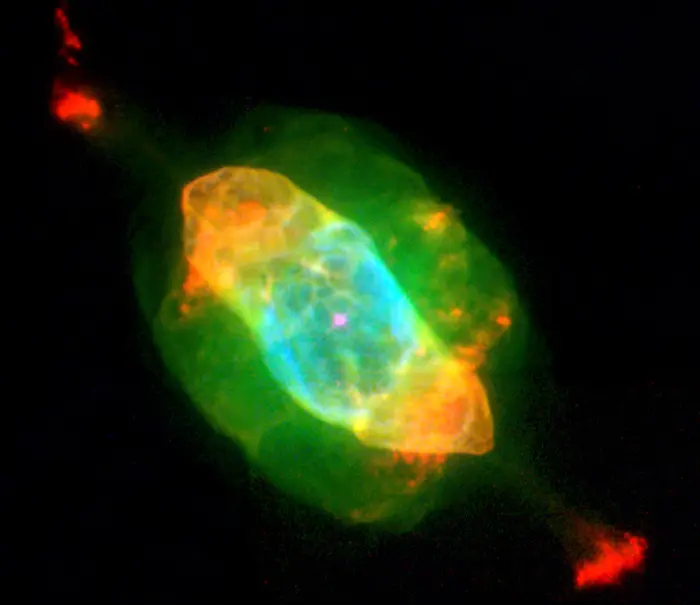
Garden-variety stars like the Sun live fairly placid lives in their galactic neighborhoods, steadily churning out heat and light for billions of years. When these stars reach retirement age, however, they transform into unique and often psychedelic works of art. This Hubble Space Telescope image of Caldwell 55, also known as the Saturn Nebula and NGC 7009, shows the result, called a planetary nebula. While it looks like a piece of wrapped cosmic candy, what we see is actually the outer gaseous layers of a star at the end of its life cycle. Stars are powered by nuclear fusion, but each one comes with a limited supply of fuel. When a medium-mass star exhausts its nuclear fuel, it will swell up and shrug off its outer layers until only a small, hot core remains. The leftover core, called a white dwarf, is a lot like a hot coal that glows after a barbecue — eventually it will fade out. Hubble took this image in visible light using the Wide Field and Planetary Camera 2 in 1996. Using Hubble’s observations, scientists have characterized the nebula’s composition, structure, temperature and the way it interacts with surrounding material. Studying planetary nebulae is particularly interesting since our Sun will experience a similar fate around five billion years down the road. Image credit: Bruce Balick (University of Washington), Jason Alexander (University of Washington), Arsen Hajian (U.S. Naval Observatory), Yervant Terzian (Cornell University), Mario Perinotto (University of Florence, Italy), Patrizio Patriarchi (Arcetri Observatory, Italy), NASA/ESA (CC BY 2.0 DEED)
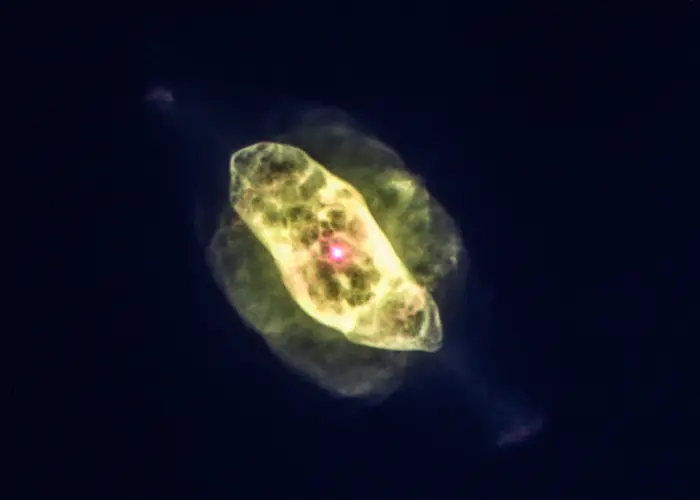
Saturn Nebula by the Hubble Space Telescope (HST), image credit: NASA/ESA/Kevin M. Gill (CC BY 2.0 DEED)
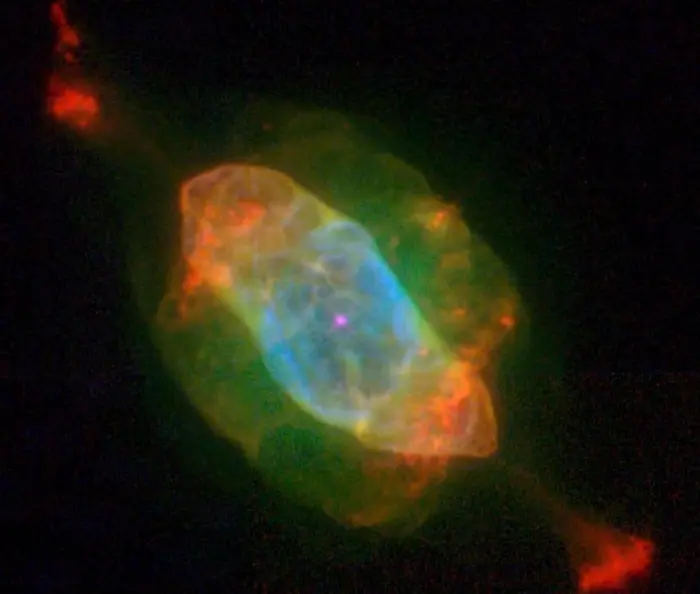
A Hubble image of the Saturn Nebula, image credit: B. Balick (U. Washington) et al., WFPC2, HST, NASA
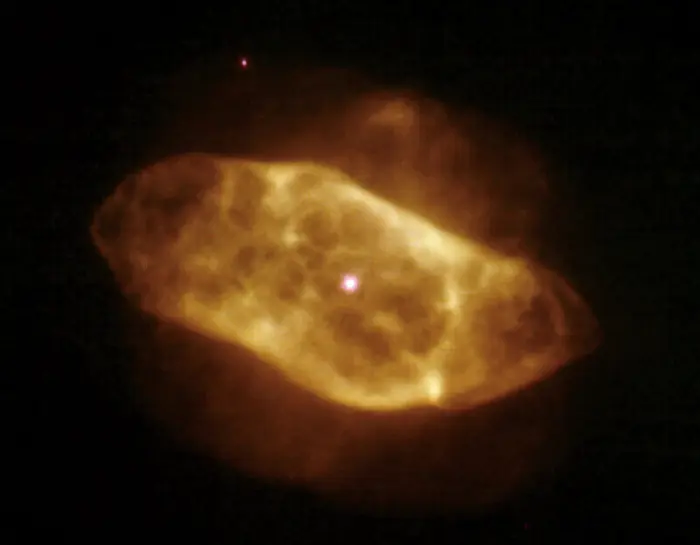
This Gemini North image shows the well-known planetary nebula NGC 7009 (the Saturn Nebula) in the near infrared with adaptive optics. The image has a full-width-half-maximum of 0.1 arcsecond (K band) and was produced by combining ALTAIR/NIRI images in K, Br-gamma, and H₂ (1-0) bands. The data were obtained in October, 2006 and are now available on the Gemini Science Archive. Image credit: International Gemini Observatory, National Optical-Infrared Astronomy Research Laboratory (NOIRLab) (CC BY 4.0 DEED)
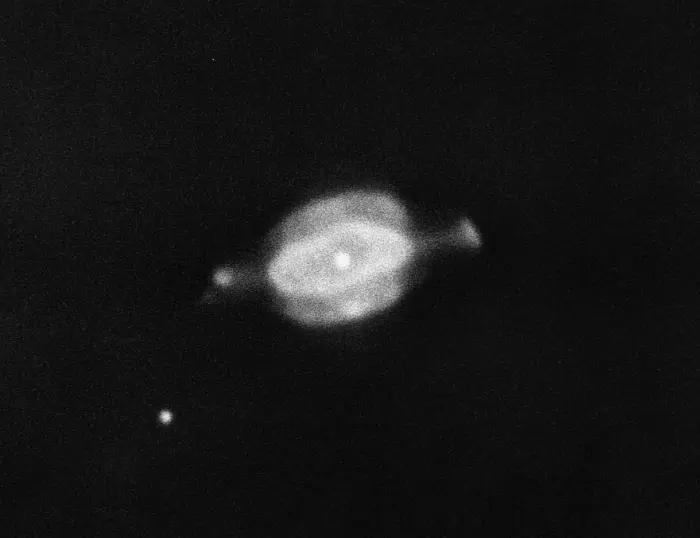
The Saturn Nebula, NGC 7009, in the constellation Aquarius, as seen by the KPNO 2.1-meter telescope in 1975. Image credit: NOIRLab/NSF/AURA (CC BY 4.0 DEED)
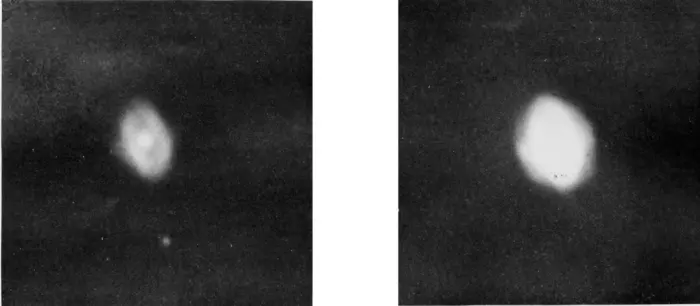
An image of the Saturn Nebula from The Popular Science Monthly, Volume 87 (1915)